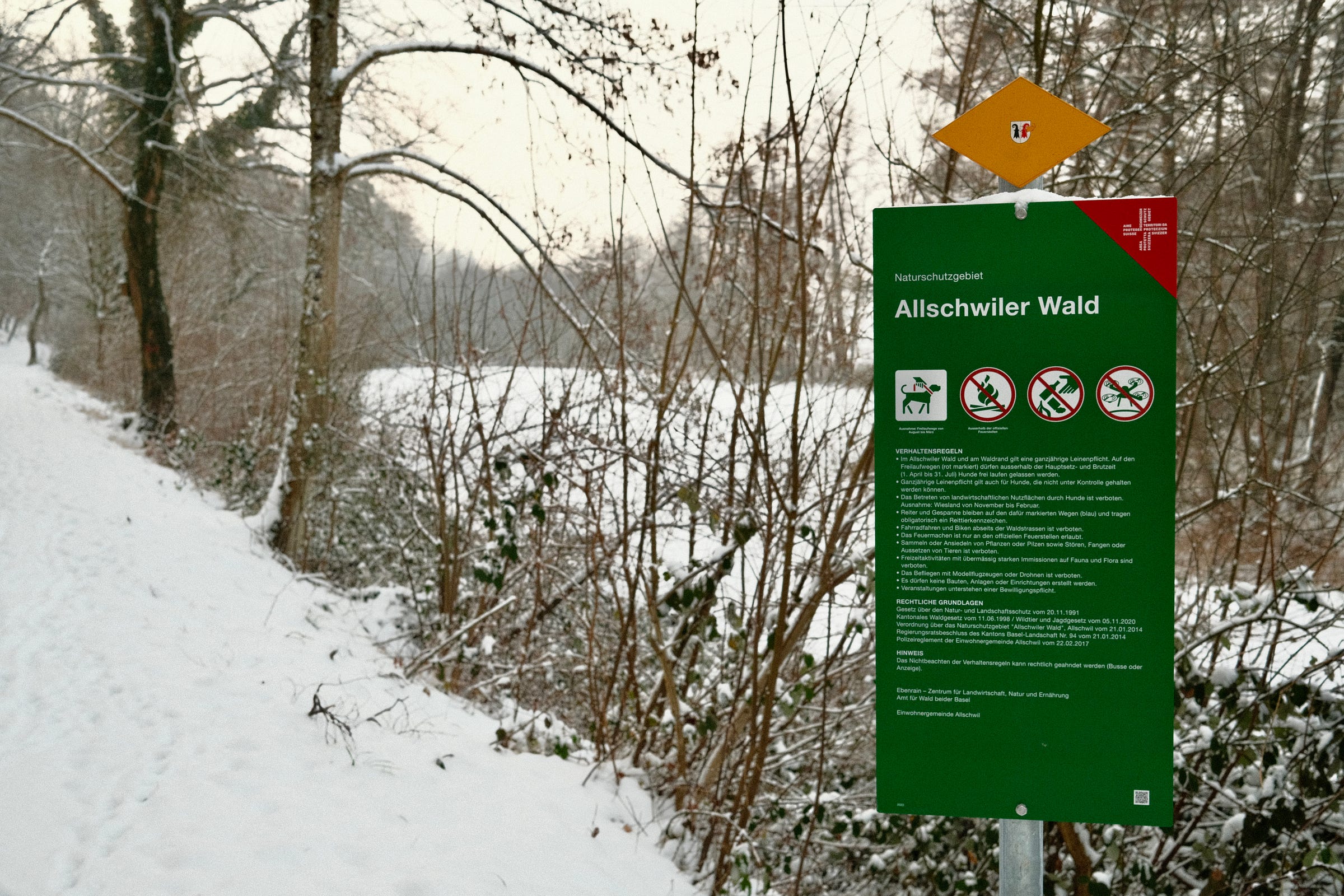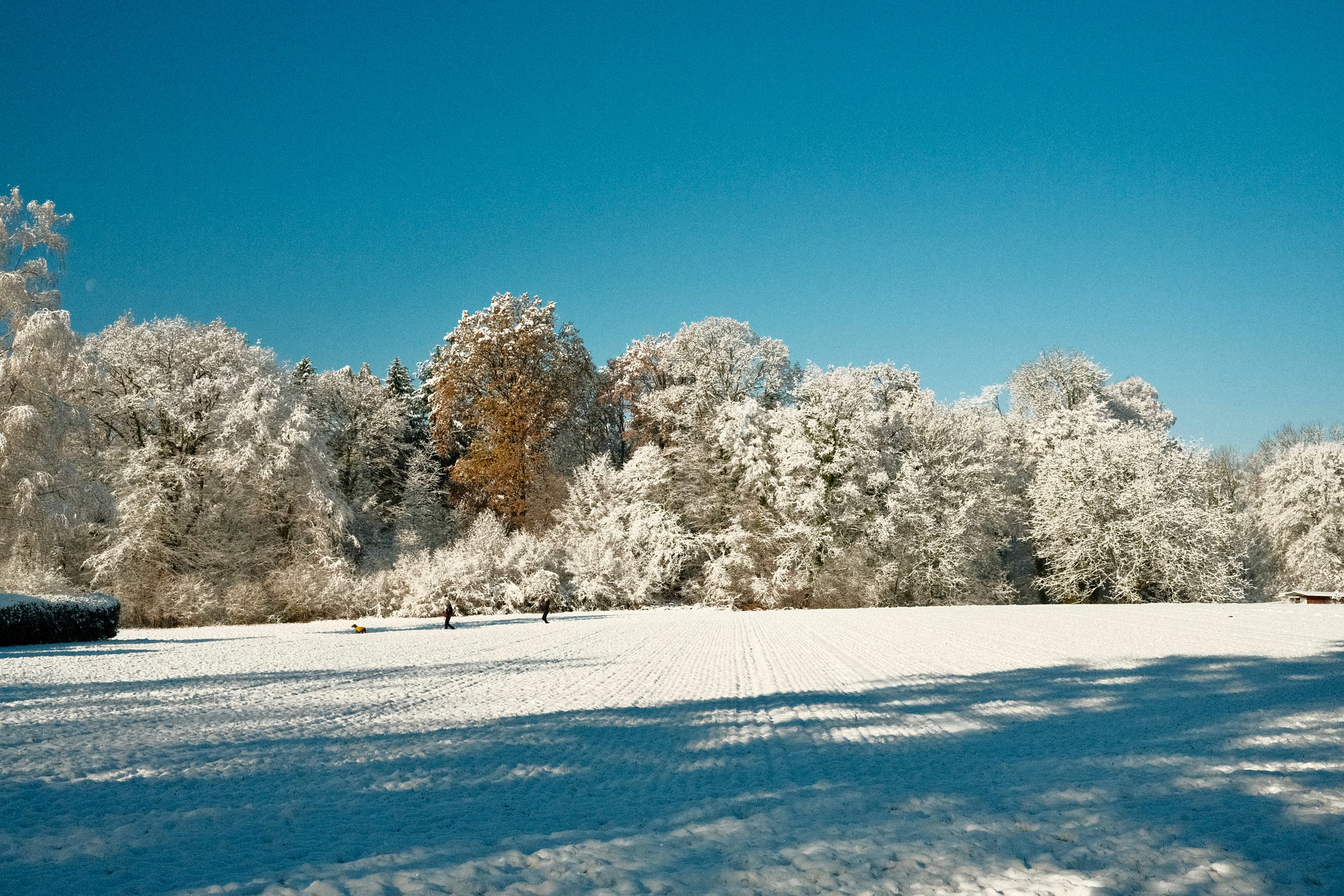On a surprisingly snowy morning early in the year, I lingered by the kitchen window and had a couple extra cups of coffee. I watched as the snow, which must have fallen steadily for most of the night, thinned into flurries, then stopped entirely.
The lights came on in the neighbors’ houses and the chimneys puffed out smoke. Through the clouds I could see the frozen branches of the woods outside of town—the Allschwiler Wald, a 600-acre reserve that’s separated from the Black Forest by national boundary, nomenclature, and a few farms.
Since moving in, I’d spent a lot of time at the window looking at the woods. I watched the horizon turn from dark green to orange to brown to its current shade, a grayish white that blended into the sky. The sky had been gray for weeks. When the snow stopped, a few streaks of blue came out.
I decided to go for a walk.
I looked through the closet by the front door for what I called my “snow coat.” It’s a dark blue Eddie Bauer parka from the 1980s. It has flannel lining, four big patch pockets that seal with velcro, a generous hood, and a cable that cinches the waist. I inherited the coat in 2005, when my grandfather died. I always wonder how it hung on him. He was slimmer than me, but the coat is quite full when I put it on. The shoulders fall halfway to my elbow and the sleeves hang a few inches past my fingers if I don’t fasten the velcro cuffs. I could fit a second person into the body of the coat.
The only picture I have of my grandpa in winter is from a few months before he died. A sudden snowfall on the day after Christmas sent us to the local park to do some sledding. On my first run down the hill, I veered off track and ramped off the roof of a baseball dugout, landing somewhere near the pitcher’s mound. The fall broke my sunglasses, but spared the digital camera in my pocket. After I got over my daze, I limped back to where I started and took the picture: my grandpa, smiling in the snow on the top of a hill. He’s wearing a different coat. In both my mind’s eye and in technical resolution, this is the clearest image I have of him.
Under the coat, I wore an old sweater my dad gave me. A couple years ago, on a visit home, he opened a cedar chest full of wool crew neck pullovers and told me to take what I wanted. I took almost everything. The sweaters were in great condition, even though they were all forty or more years old.
Before I took off, I made a pot of tea and poured into an old thermos that I got from my grandma. I sealed it and dropped it into one of the coat’s gigantic pockets, along with a pair of headphones and a small package of crackers.
Fully equipped in hand-me-downs, I went to the woods.
Thoreau went to the woods to live deliberately; I went to wander aimlessly.1 The German word for “to hike” is wandern, and that’s what I did. I hadn’t spent much time in these woods and I didn’t know the trails. I didn’t know enough German to read the wayfaring signs. I couldn’t see the sun to determine which way I was walking, and even if I could, I didn’t know which direction I lived in.
I figured I would follow other people’s footprints, but there were none. I must’ve been the first person out that morning. I skipped my headphones and decided to enjoy the quiet. I remember learning in science class that snow absorbs sound. It deadens it. By sight, the woods looked dead, too, but I occasionally saw a sign of something that didn’t hibernate or fly south—minute paw and claw prints on the trail. I spent most of the walk looking down at them.
So of course I got lost.
I walked into a clearing to see if I could spot any landmarks, but before I could get my bearings, a gust of wind turned my loose coat into a parachute and knocked me backward. I pulled my arms into the coat and cinched the waist tight then pushed my hands back through the sleeves, fastened my hood and sealed my cuffs. With a few snaps and tugs, I took on a silhouette that wasn’t exactly sleek, but a lot less lumpy than I was when I set out.
Newly secured, I walked back to the woods and sat on a log. I decided not to use my phone to find my way out. I didn’t have anything else to do that day and I knew the woods were surrounded by towns, farms, and roads. I could get out on my own. If not, my phone would still be there. I drank some tea, ate some crackers, and hoped that if I stayed still long enough, I might see some hawks or one of the rodents they eat. I gave up after a few minutes when sleet started to fall.
Listening to the sound of ice plinking against my hood made me appreciate the coat all the more. I don’t know that I would’ve bought a weatherproof parka on my own. I’ve lived in a city my entire adult life and my outerwear purchases veered toward things I could wear to the office. All of those clothes are moot now that I work from home. I’m alone most of the day. When I do go out, I’m constantly reminded I’m a foreigner here, and it takes away the confidence I would otherwise get from wearing a particularly tasteful jacket.
Besides, as cliche as it sounds, they don’t make coats like this anymore. At least, not in my price range. My most rugged (and most expensive) piece of outerwear is a waterproof jacket from one of those legacy brands that touts a tradition of quality, but it’s been a disappointment—after one season the zipper needed replacing and the stitching holding the lining was coming undone. The next year I took it in to fix a tear in the pocket. It’s currently due for another trip back to fix a hole in the sleeve.
The same is true with sweaters. I’ve taken pains to keep my closets moth-free and to avoid nails and snags, but new sweaters barely last a year before being riddled with pills and rips. It’s been reported that clothes are getting worse—even luxury brands weave plastic into their sweaters. This lets them use lower-grade yarn, and it makes the clothes fall apart faster. Even expensive things are cheap. We’ve largely come to take this for granted because it’s so easy to just order something new. We don’t need clothes to last long, so they’re not made to last long. It’s a cycle that keeps repeating, faster and faster.
It goes beyond clothes. I used to wear an Apple Watch, but now it can’t run the latest software and the battery barely holds a charge. The phone that I decided would be my lifeline if I were truly lost in the woods might not make it one more year. I don’t know how many computers I’ve been through.
How many winters have my coat and sweater been through? More than me, for sure. How many pots of coffee have passed through my thermos?
Thinking about the things I had made me think about the people who had them before me. Here I was lost in the woods in another country, but I felt like I was home.
The noise on my hood got louder. I thought maybe I could turn back and get out the way I came in, but my footprints were gone. It was like I hadn’t left anything behind, like I wasn’t here at all.
I pushed on until I got to a road. The peace of the woods was gone. A tractor plodded through the slush. A plane passed overhead. Without any kind of trail, I walked in the street against the flow of traffic. When a car came, I climbed up a ridge into a field and waited, standing next to thrown-out soda bottles and crinkled potato chip bags. I wondered how long the trash would be there.
The road took me back to town and I found my way home. I hung the snow coat over the tub, lit a fire in the fireplace, and put a record on the turntable. In addition to the sweaters, Dad gave me a huge collection of vinyl. I sent him a text then laid down on the couch. I pulled the sleeves of my old sweater over my hands until the fire got going.
It used to bug me when people described memories as “warm and fuzzy.” But I guess I see the point now.
Note: This is the first in a series I’m working on about the woods near my apartment. Stay tuned for more essays on nature and memory in the coming months.
The National Council of People Who Write About Forests requires at least one mention of Henry David.










Really enjoyed this, Gabe. The Thoreau shoutout was definitely required. Best to Linda.